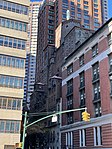15 Central Park West

15 Central Park West (also known as 15 CPW) is a luxury residential condominium along Central Park West, between 61st and 62nd Streets adjacent to Central Park, on the Upper West Side of Manhattan in New York City. It was constructed from 2005 to 2008 and was designed by Robert A.M. Stern Architects in the New Classical style. The building consists of two sections: "the House", a 19-story structure occupying the eastern part of the city block, and "the Tower", a 35-story structure occupying the western part of the block. It has 202 apartments, of which 134 are in the Tower and 68 are in the House. Both the House and the Tower contain several setbacks, complementing the design of older apartment buildings on Central Park West. The tower rises above a retail podium, which faces west toward Broadway. The two sections are connected by an elliptical entrance pavilion, which abuts a cobblestone courtyard and a private garden. The façade of 15 Central Park West is made of Indiana limestone, with large window openings and metal balconies. The building's main entrance on Central Park West connects with two lobbies, one for each section of the building. Each unit has one to eight bedrooms, and there are also studio apartments for servants. The building also contains amenities such as a fitness center, wine cellar, and movie-screening room. 15 Central Park West was built on the sites of the Mayflower Hotel, which dated from 1926, and a vacant lot. In May 2004, a joint venture composed of Arthur and William Lie Zeckendorf, Whitehall Street International, and Global Holdings Inc. purchased the Mayflower and the adjacent vacant lot for $401 million. Robert A.M. Stern Architects was selected to design the building in August 2005, and construction began the next month, when the building's sales office opened. All apartments had been sold by early 2007, and the first tenants moved into the building in early 2008. Following 15 Central Park West's opening, many condominiums were sold at high prices. Its residents have included actors, athletes, CEOs, hedge fund managers, and entrepreneurs.
Excerpt from the Wikipedia article 15 Central Park West (License: CC BY-SA 3.0, Authors, Images).15 Central Park West
Central Park West, New York Manhattan
Geographical coordinates (GPS) Address External links Nearby Places Show on map
Geographical coordinates (GPS)
| Latitude | Longitude |
|---|---|
| N 40.769722222222 ° | E -73.981111111111 ° |
Address
15 Central Park West
Central Park West 15
10023 New York, Manhattan
New York, United States
Open on Google Maps







